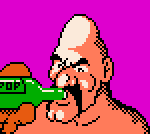After learning about the Multiple Arcade Machine Emulator and perusing arcade cabinets other people built from scratch, my first inclination was to recreate the look and feel of that old Punch-Out!! cabinet that sat in the back of my local arcade and many other arcades across the nation. Looking back now that I've finished it, if I were going to build it again, I think I would have put just a little more time into making it look like the original Nintendo cabinet. That said, it looks very close in some ways, and it's more of a Punch-Out!! style cabinet than a reproduction. Instead of just playing Punch-Out it also serves as a machine that can play thousands of different different games and has a 3" trackball along with joysticks for two players with six buttons for each. The control panel is rather wide, about 28" to better accomodate two players standing side by side.
I decided to pay homage to Punch-Out!! and Nintendo in general by labeling the machine "Punch-Out!! 25th Anniversary Edition." The actual 25th anniversary of Punch-Out isn't until 2009, but hey, I'll be ready for it! I placed pictures of some rendered Nintendo characters like Samus Aran, Mario, Luigi and Link on the front of the control panel along with their 8-bit pixellized counterparts -to show how far video games have advanced graphics-wise since the days of NES and local arcades. Getting these nice graphics on the machine was easy because of mamemarquees.com, but I will get to that part later.
Unfortunately I didn't document the building process of this cabinet very well. That is something I wish to do better with my next projects.
First, I needed material to build a cabinet housing with. Usually they are made of MDF, Particle Board or Plywood... so I had some cheesy ol' Sauder furniture (hey I won't lie, I still have Sauder furniture that I actually use, but I will admit that a lot of it is indeed cheesy) lying around that I used for sides of the cabinet and such. I made up a plan for the height, width etc. and cut them up, screwed and glued with Titebond III. Soon I had something like this below which I fitted with a 25" Magnavox TV and my old Dell 4550 Pentium IV 2.4 ghz computer. The speakers you see are Bazooka 4" car speakers. I simply ripped the left and right speakers off a Creative 2.1 PC speaker system (with subwoofer) and hooked the Bazooka 8ohm speakers up to it instead. The result was amazing, much more powerful and clear than the pc speakers.
 Additionally, I found a 12" lcd on eBay for a rather cheap price. I wanted this because the developers of M.A.M.E. enabled dual screen support so a game like Punch-Out!! can utilize both screens just like the arcade version. It arrived with no dead pixels yet the viewing angles are rather poor and it only does 640x480 resolution. That might matter if you were using it in some other way, but for this project it is perfect since you can't really view it from the sides plus 640x480 is exactly the resolution I wanted. A normal TV will use that resolution while being fed from a PC graphics card with TV-Out. Classic arcade aficionados would probably opt for real arcade monitors which can be expensive, but I've found 640x480 works nicely for me and the extra large TV screen is especially good for two players.
Additionally, I found a 12" lcd on eBay for a rather cheap price. I wanted this because the developers of M.A.M.E. enabled dual screen support so a game like Punch-Out!! can utilize both screens just like the arcade version. It arrived with no dead pixels yet the viewing angles are rather poor and it only does 640x480 resolution. That might matter if you were using it in some other way, but for this project it is perfect since you can't really view it from the sides plus 640x480 is exactly the resolution I wanted. A normal TV will use that resolution while being fed from a PC graphics card with TV-Out. Classic arcade aficionados would probably opt for real arcade monitors which can be expensive, but I've found 640x480 works nicely for me and the extra large TV screen is especially good for two players.to be continued...


